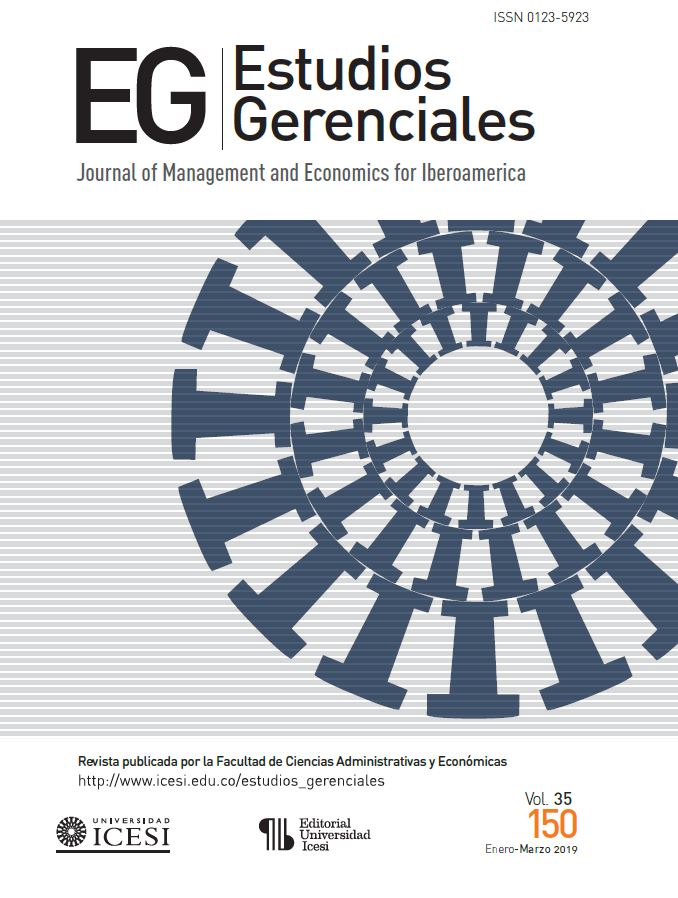The binomial model, tax savings and adjusted value of the firm by scenarios of continuity or dissolution
DOI:
https://doi.org/10.18046/j.estger.2019.150.2903Keywords:
Binomial model, Tax savings, Liquidation, Continuity, Adjusted valueAbstract
The traditional version of the discounted cash flow model does not include contingent values of tax savings and the scenarios of continuity or dissolution that the firm faces. Based on the real options theory, this paper develops a binomial valuation model that includes the contingent treatment for tax savings and the continuity or dissolution scenarios, conditioned by the level of indebtedness. In order to accomplish this, the methodological approach of case study was used, exposing functional relationships and advantages concerning the discounted cash flow. The results indicate that the value of the firm is adjusted to an exponential-type function. The current value obtained resumes contingent tax savings and dissolution or continuity scenarios.
Downloads
References
Booth, L. (2002). Finding Value Where None Exists: Pitfalls in Using Adjusted Present Value. Journal of Applied Corporate Finance, 15(1), 8-17. https://doi.org/10.1111/j.1745-6622.2002.tb00344.x
Booth, L. (2007). Capital Cash Flow, APV and Valuation. European Financial Management, 13(1), 29-48. http://dx.doi.org/10.1111/j.1468-036X.2006.00284.x
Brandao, L., Dyer, J. y Hahn, W. (2005). Using Binomial Decision Trees to Solve Real Options Valuations Problems. Journal of Decision Analysis, (2), 69-88. https://doi.org/10.1287/deca.1050.0040
Broadie, M. y Kaya, O. (2007). A Binomial Lattice Method for Pricing Corporate Debt and Modelling Chapter 11 Procedings. Journal of Finance and Quantitative Analysis, 42(2), 279-312. https://doi.org/10.1017/S0022109000003288
Castro Monge, E. (2010). El estudio de casos como metodología de investigación y su importancia en la dirección y administración de empresas. Revista Nacional de Administración, 2(1), 31-54.
Chance, D. (2007). A Synthesis of Binomial Option Pricing Models for Lognormally Distributed Assets. Social Science Research Network -SSRN. Recuperado el 11 de noviembre de 2011: Recuperado el 11 de noviembre de 2011: http://dx.doi.org/10.2139/ssrn.969834
Cooper, I. y Nyborg, K. (2006). The Value of Tax Shields IS Equal to the Present Value of Tax Shields. Journal of Financial Economics, 81, 215-225. https://doi.org/10.1016/j.jfineco.2005.07.003
Copeland, T., Koller, K. y Murrin, J. (2000). Valuation: Measuring and Managing the Value of Companies (3 ed.). New York: Wiley.
Cox, J., Ross, S. y Rubinstein, M. (1979). Option Pricing: A Simplified Approach. Journal of Financial Economics, 7, 229-263. https://doi.org/10.1016/0304-405X(79)90015-1
Damodaran, A. (2006). Damodaran on Valuation (2 ed.). New York: John Wiley & Sons.
Farber, A., Gillet, R. y Szafarz, A. (2006). A General Formula for the WACC. International Journal of Business, 11(2), 211-218.
Fernández, P. (2014). Valoración de Empresas y Sensatez (3 ed.). Barcelona: IESE Business School-Universidad de Navarra.
Gisiger, N. (2010). Risk-Neutral Probabilities Explained. Social Science Research Network-SSRN. Recuperado el 19 de junio de 2014 de: Recuperado el 19 de junio de 2014 de: http://dx.doi.org/10.2139/ssrn.1395390
Guimaraes Dias, M. (2015). Análise de Investimentos com Opcoes Reais. Rio de Janeiro: Editora Interciencia Ltda.
Inselbag, I. y Kaufold, H. (1997). Two DCF Approaches for Valuing Companies under Alternative Financing Strategies and How to Choose between Them. Journal of Applied Corporate Finance, 10, 114-122. https://doi.org/10.1111/j.1745-6622.1997.tb00132.x
León, A., Mencia, J. y Sentaria, E. (2007). Parametric Properties of Semi-Nonparametric Distributions, with application to Options Valuation. Documento de Trabajo 0707, Banco de España, 9-30.
Milanesi, G. (2013). Asimetría y Curtosis en el Modelo Binomial para valora Opciones Reales: caso de aplicación para empresas de base tecnológica. Estudios Gerenciales Journal of Management and Economics for Iberoamerica, 29(128), 368-378. https://doi.org/10.1016/j.estger.2013.09.011
Milanesi, G. (2014). Modelo Binomial para la Valoración de Empresas y los efectos de la Deuda: Escudo Fiscal y Liquidación de la Firma. Journal of Economics, Finance and Administrative Science, 19(36), 2-10. http://dx.doi.org/10.1016/j.jefas.2014.03.004
Miles, J. y Ezzell, J. (1980). The Weighted Average Cost of Capital, Perfect Capital Markets and Project Life: A Clarification. Journal of Financial and Quantitative Analysis, 15, 719-730.
Miles, J. y Ezzell, J. (1985). Reformulation Tax Shield Valuation: A note. Journal of Finance, 40, 1485-1492. https://doi.org/10.2307/2330405
Modigliani, F. y Miller, M. (1963). Corporate Income Taxes and the Cost of Capital: A Correction. American Economic Review, 53, 433-443.
Oded, J. y Michel, A. (2007). Reconciling Valuation DCF Methodologies. Journal of Applied Finance, 17(2), 21-32.
Ruback, R. (2002). Capital Cash Flows: A simple approach to valuing risky cash flows. Financial Management, 31(2), 85-103.
Rubinstein, M. (1998). Edgeworth Binomial Trees. Journal of Derivatives, (5), 20-27.
Smith, J. (2005). Alternative Approach for Solving Real Options Problems. Decision Analysis, (2), 89-102.
Taggart, R. (1991). Consistent Valuation and Cost of Capital Expressions with Corporarte and Personal Taxes. Financial Management, 20, 8-20.
Tham, J. y Wonder, N. (2001). Unconventional wisdom on PSI, the appropriate discount rate for the tax shield. Social Science Research Network-SSRN. Recuperado el 25 de agosto de 2012: Recuperado el 25 de agosto de 2012: http://dx.doi.org/10.2139/ssrn.282149
Tham, J. y Velez Pareja, I. (2001). The Correct Discount Rate for the Tax Shield: the N-Period Case. Working Paper submitted to the European Financial Management Association.
Tham, J. y Wonder, N. (2002). Inter-temporal resolution of risk: The case of the tax shield. Social Science Research Network-SSRN. Recuperado el 18 de agosto de 2012: Recuperado el 18 de agosto de 2012: http://dx.doi.org/10.2139/ssrn.308039
Velez Pareja, I. (2016). Tax shields, financial expenses and losses carried forward. Cuadernos de Economia, 35(69), 663-689. http://dx.doi.org/10.15446/cuad.econ.v35n69.54352
Downloads
Published
Issue
Section
License
Articles are the sole responsibility of their authors, and will not compromise Icesi’s University principles or policies nor those of the Editorial Board of the journal Estudios Gerenciales. Authors authorize and accept the transfer of all rights to the journal, both for its print and electronic publication. After an article is published, it may be reproduced without previous permission of the author or the journal but the author(s), year, title, volume, number and range of pages of the publication must be mentioned. In addition, Estudios Gerenciales must be mentioned as the source (please, refrain from using Revista Estudios Gerenciales).








